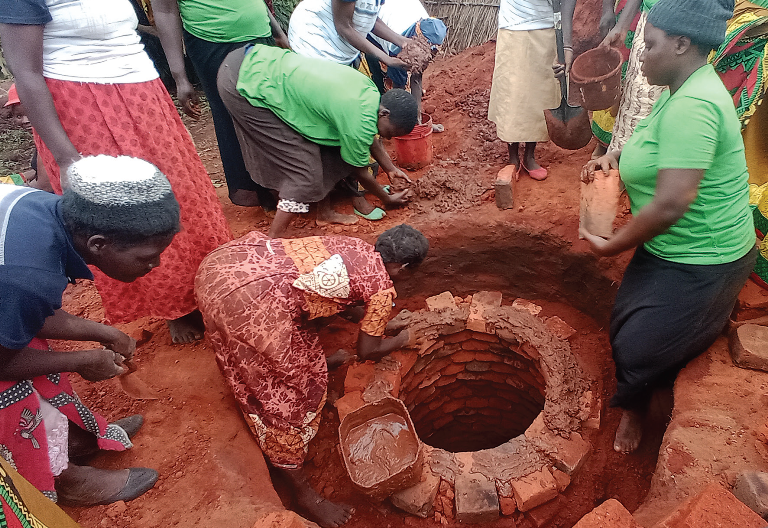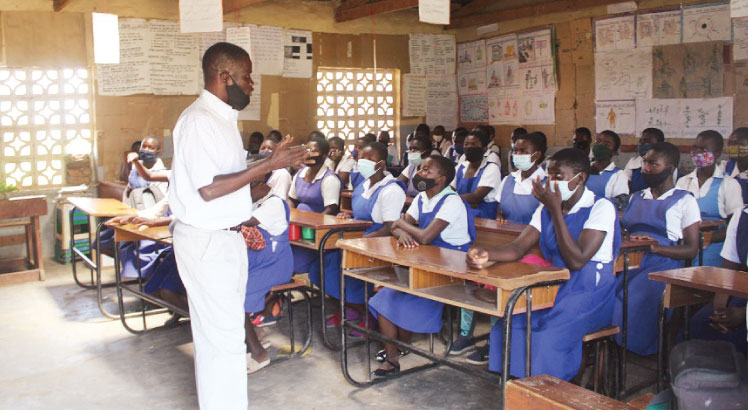Women unite to end open defaecation
Located about 25 kilometres from Mponela in Dowa District, Choma in Traditional Authority Chakhaza is a model village in business sanitation.
Filth littered on ground is a rare sight. In people’s homes, sanitary facilities such as toilets, clean cooking places, drying ropes, racks, rubbish pits and washrooms are common.

While admiring the tidy surroundings, people’s hospitality is another inescapable salient feature of the tiny village, tucked between Madisi Trading Centre to the northwest and Ntchisi to the east.
As the ecstatic joys of children tear into the morning atmosphere, women, men and school children embark on the day’s business.
But amid the hustle and bustle, a group of women is engrossed in digging a resilient corbelled latrine for one of them. The community members have christened it Mwamuna Apumule because once constructed, it can be used for about 15 to 30 years; hence, making a man take a break from digging latrines every year.
Supervising the activity is village head Choma and health surveillance assistant Adson Yohane.
Why resilient latrines
In 2017, Dowa achieved an open-free defaecation (ODF) status following water, sanitation and hygiene (Wash) interventions implemented by World Vision Malawi in the district since 2008.
But barely two years after the milestone, many households slid back into unsanitary conditions as their latrines collapsed.
The situation threatened to reignite the spread of waterborne diseases the communities thought they had done away with. To sustain the ODF status, the organisation introduced a new technology—the corbelled latrine.
Efilida Gwani, whose family had no reliable toilet, says the organisation took advantage of the women’s village savings and loans (VSLs) groups to introduce a loan facility specially for constructing toilets.
She explains: “We call it chimbudzi cha loan. For this account, members contribute money which they borrow to construct a corbelled pit latrine and repay at an agreed interest after 30 days.
“I chose to construct an improved toilet, so I borrowed K30 000 in 2019 for the project.”
Gwani says since then, no strong wind or high water has damaged the facility.
But, there is also hope for vulnerable households who can borrow K12 500 to construct a low-class facility.
Madalo Gracian, who constructed hers in 2019, says the difference between an improved latrine and low-class one is on housing.
“An improved facility has an iron-sheet roof and a cement floor while a low-class facility is thatched with grass,” she says.
Nevertheless, Gracian says the lifespan of the latrine remains the same, if anything, she will just need to replace the roof, after six years or so.
Perhaps to show that the resilient toilets enable men to rest from the hustles of digging latrines, it is women in Choma Village who dig the pits.
The technology
The resilient latrine is different from the ordinary one in that it requires a lot of technicalities.
Bertha Phiri says firstly, they identify a place10 metres (m) away from a house and 100m away from a water source. They then clear the land where the hole will be dug.
“Being a rural setting, we use locally available materials such as hoes, tree-ladders, ropes or strings, tape measure, shovels, bricks, pail, poles, panga knives and brick lying knife,” she says.
With perspiration shining on her forehead, Bertha draws a circle with a radius of four metres and an inscribed circle measuring 1.5 metres (m) in radius. She then divides the 1.5m radius and starts digging. The other women join the work, one after another, pushing the soil to one side.
When they reach 1.5m down, put the soil on one side until they go down 1.5m down, another woman measure a 1m radius and dig a small hole for another 1.5m. They put this soil on the opposite side.
When the digging is over at 3m down, they make three balls of soil; one from the two separate mounds of soil and a third one from the mixture of the soil from the two mounds.
The balls are placed in water for the whole night to check the recommended type of soil for construction works to pave the sides of the hole with burnt bricks. The mud is preferred to cement as it allows air to pass through the sides freely, thereby making the toilet last long.
The project’s impact
According to World Vision Malawi director of operations Charles Chimombo, since 2017, the project has constructed 789 middle-class toilets and 1 121 low-class toilets.
“The number of beneficiaries for the Sanitation Business Model is 8 762 with 1101 registered children,” he says.
Chimombo says the corbelled toilet lasts between 15 and 25 years. “The latrines are environmental friendly as few ecosystem is disturbed during construction because the technology needs fewer trees and for roofing only.”
Thus, he says, the technology has come at the right time when most communities are grappling with the effects of climate change such as floods and droughts, resulting from deforestation, among others.
But Chimombo also argues that due to its durability, land is saved because people will not dig many latrines within a short time. However, he says this being a model village, they are planning to scale up the technology across the country.
Currently, districts that have achieved ODF status have done so with ordinary latrines which are susceptible to collapsing, especially during the rainy season, thereby threatening the gains of the initiative.
“So, the resilient toilets are the way to go to ensure people live healthy lives through improved sanitation,” says Chimombo.
According to Ministry of Health preventive health director Storm Kabuluzi, government introduced the ODF initiative in 2008 to improve public health in communities.
“We are recording fewer hygiene-related infections than before. In the past, we were haunted by waterborne diseases such as diarrhoea due to carelessness in easing oneself,” he says.
Kabuluzi commends partners implementing the community-led total sanitation and hygiene programme in the country for complementing government’s efforts to improve public health.
But thanks to the women of Choma Village, waterborne diseases have declined over the past three years in the area, courtesy of the initiatives, according to Chinkhwiri Health Centre senior health surveillance assistant (HSA) Adson Yohane.
He says about 50 households have undergone training in sanitation marketing and have influenced more than 1 950 to construct toilets with hand-washing facilities.
Explains Yohane: “In the past six years, the hospital used to register many waterborne-related illnesses. But now the cases have dropped.
“In 2017, for instance, we registered 100 diarrhoea cases but, this year, we only registered 17.”
He says to ensure community members sustain the gains of the initiative, Ministry of Health empowered HSAs to enforce public health interventions in the area.
Yet, at the centre of the success story is village head Choma, a man who takes pride in his subjects for turning the village into an epitome of cleanliness.
The chief recalls that not many years ago, a majority of his subjects used to relieve themselves in bushes.
“But that is a story of the past as every household now has a corbelled latrine and since their construction in 2019 and 2010, they are still standing,” says Choma.
Even more gratifying for the chief is the fact that all the toilets are constructed by women.
“This has broken the stereotypes men throw at women that they cannot do some things done by men such as constructing toilets, houses or digging graves,” he says.
Water for all
To complement the toilet interventions, the organisation since 2008, has drilled 146 boreholes and installed five piped water systems in the area. Now community members can afford a smile because of access to clean water.
Margaret Paulo says for many years, women used to wake up early in the morning to rush to wells to draw water before animals contaminated them.
She explains that at times, some women braved long distances to get drinking water from communities that had functioning boreholes.
Paulo recollects that the situation affected many families as some husbands started suspecting their wives of cheating as they used to take long at water sources.
“School children were also usually late for classes because they had to wait for water to clean themselves,” she says.
Paulo’s sentiments come on the backdrop of the Covid-19 pandemic which is preventable by personal hygienic practices such as washing hands regularly with soap.
At Chinkhwiri Trading Centre, jubilant children ensured they washed their hands before eating any food or going to classes, just to ensure they are clean.
Water, sanitation situation
While one village has achieved almost everything in terms of Wash, the 2021 National Statistical Office survey on Multiple Indicator Cluster found that 60 percent of the country’s water sources are contaminated.
Recently, in a report issued by the Centre for Social Accountability and Transparency (Csat) in collaboration with Lilongwe University of Agriculture and Natural Resources lecturer Henry Kankwamba found that Malawi’s water accessibility rate is at 68 percent.
On the other hand, the World Health Organisation suggests that improving access to improved water, sanitation and hygiene would save 20 000 lives per year and eliminate 25 million episodes of illness.
Sustainable Development Goals (SDG) targets 6.1 and 6.2 aim for universal and equitable access to safe drinking water and sanitation by 2030.
The figures make an urgent call to action to ensure SDG number 6 is achieved in eight years. As government and its partners are working hard to improve sanitation and water availability in the country, a small village of Choma in Dowa has embraced a new technology to make pit latrines last.





